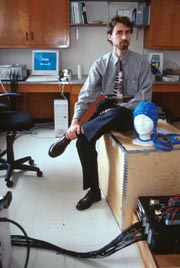
| ||
 | ||
 Neuropsychology professor Tomas Paus PHOTO: NORMAND BLOUIN/AGENCE STOCK |
A window on the developing brain
|
TIM HORNYAK | Call it a "window" on the developing brain. For the first time ever, scientists at McGill's Montreal Neurological Institute (MNI) are able to track childhood brain growth thanks to new magnetic resonance imagery (MRI) techniques.
Working with colleagues at the U.S. National Institute of Mental Health in Bethesda, Maryland, MNI researchers analyzed detailed MRI scans of the brains of 111 healthy children and adolescents aged four to 18. By processing the scans through a complex tissue-classification computer program developed by staff at the MNI's McConnell Brain Imaging Centre (BIC) and McGill's Department of Mathematics, investigators were able to observe a living brain's early structural changes. "Our study is the first to find changes in specific fibre pathways," says Dr. Tomas Paus of the MNI, the study's lead investigator. Fibre pathways connect different areas of the brain and nervous system, and are composed of bundles of many axons, the stem-like structures involved in transferring information between neurons. The brain doesn't fully mature before adolescence or adulthood, and until now, the only way to observe the structural changes in a developing brain was by looking at rare young autopsy subjects. With the new technique, the scientists are able to separately process the brain's living grey matter -- its "thinking" neurons -- from its white matter, the interconnecting axons. In the March 19 issue of the journal Science, Paus and his partners described an important discovery made during their study: the development of a critical pathway linking the frontal and temporal lobes of the brain was significantly more pronounced in the left rather than the right hemisphere. The left hemisphere controls speech in most people, and the key role of speech in cognitive growth may account for the robust development of the frontotemporal pathway, according to the researchers. "Those changes might be important for fine-tuning of language development," says Paus, "because all our subjects are aged four to 18 years, and are not just starting to talk." The investigators also found that the corticospinal pathway, which links the cerebral cortex and the spinal cord and transmits motor signals to the body's muscles, seems to develop at the same pace in both hemispheres of the brain. New knowledge about the brain being generated by imaging has been likened to explorers discovering the New World, and McGill is in a position to map out a lot of territory. The findings of the neural pathway study were possible because of the unique resources of the BIC. With more than $16 million worth of brain imaging and computer equipment as well as a team of physical, clinical and computer scientists, the BIC is the only facility in the world that can process large collections of brain-scan databases. Last week, the BIC was honoured with a Computerworld Smithsonian Award from the U.S. Smithsonian Institution for its work in advancing brain research. "The sky's the limit as far as structural imaging is concerned," says Dr. Alan Evans, BIC's coordinator and co-investigator on the pathway study. "What's exciting is that these tools are now available for studying Alzheimer's disease, and normal aging and development." One of the most intriguing possibilities of the new technology, say researchers, is the study of psychiatric disorders. Some theories of schizophrenia, for example, state that it is a developmental disorder involving genetic and environmental factors. The disease may cause the brain to "wire" itself differently, resulting in "crossed wires" and the common schizophrenic hallucination of hearing imaginary voices that often 'direct' behaviour. "You're not born schizophrenic," says Paus of schizophrenic patients. "Your one- or two- or three-year-old child or your pre-teenager is rarely schizophrenic, even though the connections are probably wrong already. One possibility is that the full-blown symptoms of schizophrenia are 'unlocked' by the maturation of the pathways. So they need to be mature to reveal the abnormalities." Paus and his colleagues are now planning their next step in understanding the growing brain, and will compare their study of neural pathway maturation in healthy children to those at risk for disorders like schizophrenia.
|
|
| |||||